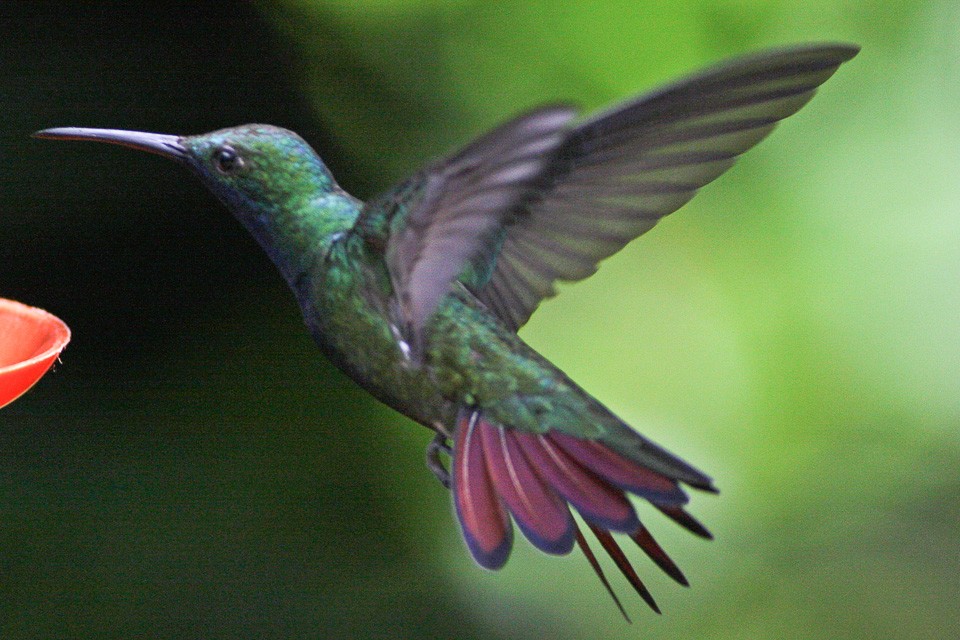Black-throated Mango
A species of Mangos Scientific name : Anthracothorax nigricollis Genus : Mangos
Black-throated Mango, A species of Mangos
Botanical name: Anthracothorax nigricollis
Genus: Mangos
Content
Description General Info
Description
It is 10.2 cm long and weighs 7.2g. The longish black bill is slightly decurved. The tail in both sexes has dark central feathers, the outer tail being wine-red tipped with black. The male has glossy bright green upperparts. His throat and chest are matt black, bordered with blue-green. The flanks are bright green, and the black of the chest tapers onto the belly. The female black-throated mango has bronze-green upperparts and white underparts with a black central stripe. Immature birds show some grey or buff feather tips on the head and wings, and have brown around the eyes. The call of the black-throated mango is a high-pitched tsiuck, and the song is a buzzing hsl-hsl-hsl-hsl-hsl-hsl-hsl. This species is very similar to the closely related green-breasted mango. Although the male black-throated mango has more extensive black on the underparts, this and other plumage differences are not always easy to confirm in the field because the birds appear all-black. The females of the two species can be almost inseparable, although the black-throated lacks the more extensively coppery upperpart of its relative. 
Size
12 cm
Life Expectancy
8 years
Nest Placement
Tree
Feeding Habits
Black-throated Mango primarily feeds on nectar and insects, exhibiting hovering abilities to extract nectar from flowers. It displays a preference for certain floral species and catches insects mid-flight, demonstrating a specialized diet with both flying and stationary feeding behaviors.
Habitat
The black-throated Mango thrives in tropical lowlands and adapts to a variety of open environments. Its habitat spans from garden-like settings with bushes and scattered trees to agricultural and forest borders. The species is versatile, inhabiting urban parks, river edges, and even disturbed landscapes. It can also be found in mountainous regions at elevations up to 2000 meters, demonstrating a broad altitude range and resilience to habitat fragmentation.
Dite type
Nectivorous
General Info
Feeding Habits
Bird food type
Distribution Area
It breeds from Panama south to northeastern Bolivia, southern Brazil and northern Argentina. It is also common on both Trinidad and Tobago. It is a local or seasonal migrant, with some birds moving up to 1000 miles, although its movements are not well understood. This small bird inhabits open country, gardens and cultivation. Though it will adapt to human activity, it seems less of a generalist than for example the gilded sapphire (Hylocharis chrysura) or the sapphire-spangled emerald (Amazilia lactea). The food of this species is nectar, often taken from the flowers of large trees. This hummingbird is also notably insectivorous, often hovering in open areas to catch flying insects. It appears to be somewhat picky regarding favorite foodplants and often does not visit ornamental plants popular with many other hummingbirds, such as Erythrina speciosa or Stifftia chrysantha; certain ornamental Bignoniaceae like the fountain tree (Spathodea campanulata) seem more to this bird's liking. While feeding, it has been observed to dominate over a glittering-bellied emerald (Chlorostilbon lucidus) and to be displaced by a gilded hummingbird, both considerably smaller species. The black-throated mango's breeding season lasts almost year-round in most of its range. It builds a tiny cup nest on a high, thin, and usually bare branch. For this it uses fluff like seed down, cladding the outside with lichen. Nests are maybe 35–40 mm wide and 25–30 mm tall on the outside and some 25 mm wide and 10–15 mm deep inside. The two all-white eggs measure c.15 by 9.5 mm. They are incubated by the female for 16 or 17 days, and fledging takes another 24. At a black-throated mango nest in Cuyabeno Faunistic Reserve, Ecuador, it was noted that the tree was beset with Pseudomyrmex stinging ants. This was also noted at a green-breasted mango nest on San Andrés Island (Caribbean). It is likely that the ants would deter predators, but it is not known whether the birds deliberately select such trees for nesting. 
Species Status
Not globally threatened.
Scientific Classification
Phylum
Chordates Class
Birds Order
Swifts and hummingbirds Family
Hummingbirds Genus
Mangos Species
Black-throated Mango 